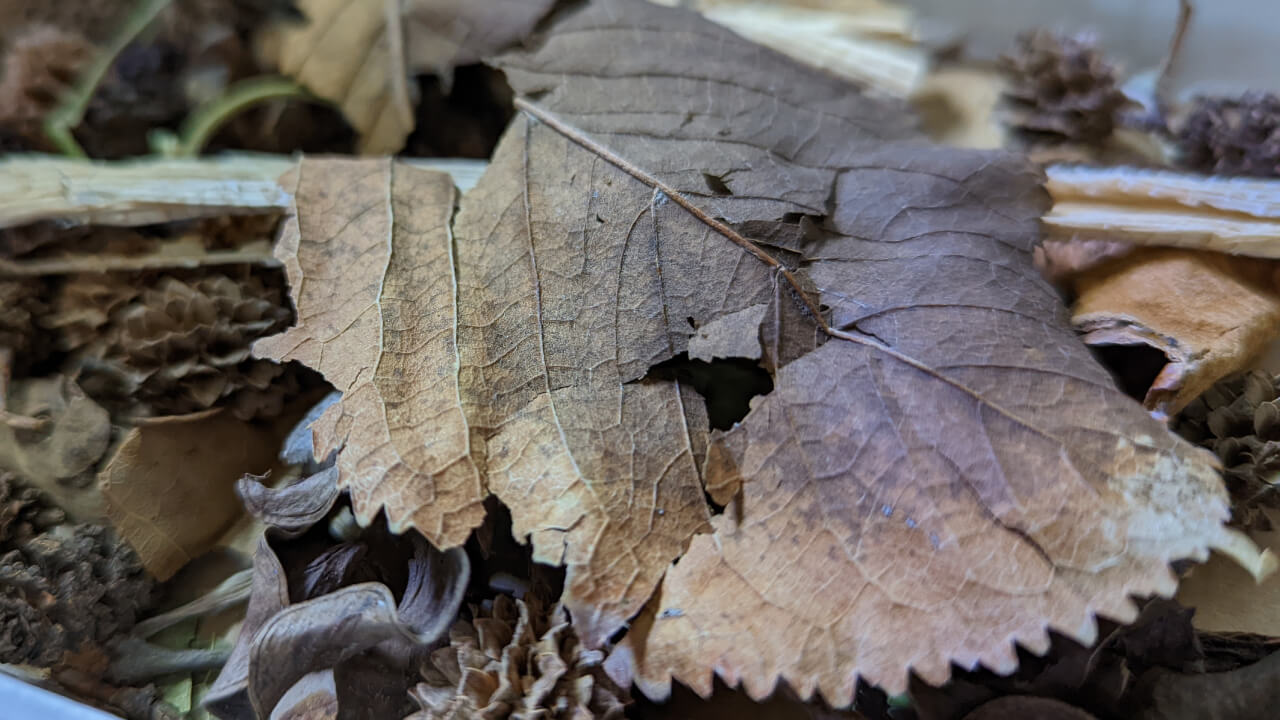Adding leaf litter to your shrimp is a great idea. They’re an excellent source of food, and make your tank a closer copy of their natural habitat.
In the wild, dwarf shrimp live in streams that have their floor covered in fallen leaves.
These plant parts, or botanicals, are mainly useful for feeding your shrimp.
Some types of leaves can also affect your water parameters, like making it more acidic. This property is very useful in Bee shrimp tanks.
Benefits of botanicals
- Long-lasting source of food
- Adds more hiding places
- Can lower pH with tannins
Long-lasting food
The leaves will slowly soften in the water, making a tasty meal for your shrimp and snails. With the right leaves, you can keep them in your water forever, they won’t pollute your water.
This makes leaf litter amazing for keeping your tank fed when you’re away, like on vacation. Most leaves will last for weeks in your tank, and some even for months.
The surface area of the leaf also provides a perfect place for growing biofilm. Biofilm will make up the vast majority of what a shrimp normally eats.
Having a lot of leaves in your tank will make it into a very productive biofilm farm, and keep your shrimp happy.
Extra hiding places for shrimp
It’s totally normal for shrimp to hide away after molting, as their shells are soft, and they feel vulnerable.
Having leaves scattered over your substrate will give them a few more places to shelter. This helps reduce any stress while their new shell hardens.
Baby shrimp also like to hide, and they normally stay in one place for their first few weeks.
Giving your baby shrimp easy access to a leaf covered in biofilm will massively improve their chances of survival.
Tannins lower the pH level
Tannins are naturally found in wood, bark, and leaves. In larger amounts, they cause your water to turn a yellowy-brown colour, known as blackwater.
The tannins also increase the acidity of the water. The amount your pH will be lowered depends on your carbonate hardness (KH), or buffering capacity.
Water with a high KH will be able to absorb a lot of tannins before you see a noticeable change in the pH. On the opposite end, low KH water will see its pH level swing more easily.
Not all leaves will release tannins into the water. Indian Almond leaves and alder cones are the most popular choices for adding tannins into shrimp tanks.
Finding the right leaves
When buying leaves online, check if they’re labelled as shrimp safe. This normally means they’re safe from pesticides and fertilizers.
If you’re collecting your own leaves, you’ll need to be careful to avoid those chemicals. Try to avoid picking leaves from where animals can easily reach them, too.
You should also only use species of leaves you know to be safe.
Which botanicals are safe for shrimp tanks?
The leaves and botanicals listed below are totally shrimp safe when properly prepared.
These lists are not complete, but cover the most popular options. You may be able to use leaves that aren’t in these lists, but double check first.
Safe leaves for shrimp
- Banana (dried)
- Guava
- Indian Almond / Catappa
- Mulberry
- Nettle
- Oak
- Teak
- Walnut
Safe botanicals for shrimp
- Alder cones
- Ceylon cinnamon bark
- Kuchila cups
- Lotus seed pod head
- Oak caps
- Wallichii pods
Adding leaves into your tank
Boil all leaves and botanicals before putting them into your shrimp tank.
The main reason is to remove the risk of infection, or anything else unwanted, sneaking into your tank.
Boiling can also help to remove a lot of tannins, which is helpful if you want to avoid having a blackwater tank.
After a few minutes, or when enough tannins have dissolved into the water, lift the leaves out and leave them to cool.
The soaked leaves should sink to the bottom of your tank and be ready to eat.

